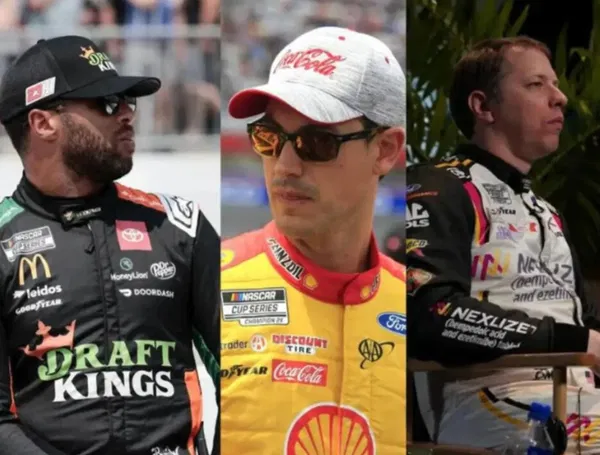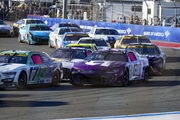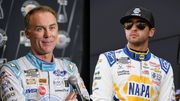
via Imago
Bubba Wallace, Joey Logano, Brad Keselowski : Image credits: Imago

via Imago
Bubba Wallace, Joey Logano, Brad Keselowski : Image credits: Imago
Brad Keselowski’s recent performance at the Brickyard 400 was a thrilling mix of strategy and near victory, echoing the fuel-saving tactics that his teammate Joey Logano has showcased previously. Starting from 26th place and facing a pit exit penalty, Keselowski’s journey was anything but smooth. But being the king of saving on fuel while on the tracks, everybody expected a little more mileage from the RFK Racing driver. So why did his plan fall short this time around? Freddie Kraft shares his take on Keselowski’s performance, breaking down the idea behind his strategy on the podcast with Casey Boat.
Keselowski’s fuel strategy gamble unveiled
Brad Keselowski‘s gamble on fuel strategy was a pivotal moment in the race at the Indianapolis Motor Speedway. Where he went from leading the pack for a significant portion of the final laps to running dangerously low as the race neared its conclusion! According to insiders, the plan for the No. 6 Ford driver was to push until he ran out of gas, which was estimated to happen just after crossing the finish line. However, this time, things did not go according to plan and cost him the checkered flag.
ADVERTISEMENT
Article continues below this ad
On the Door Bumper Clear podcast, Freddie Kraft, Bubba Wallace’s spotter, discussed the impressive fuel-saving strategy employed by Brad Keselowski during the Brickyard 400. Casey Boat kicked off the dialogue by expressing her surprise at how long Keselowski managed to stay on the track without pitting. To this, Kraft responded, acknowledging that it was no easy feat on a track like Indianapolis Motor Speedway. Adding that, while the 23XI Racing team were also trying to conserve fuel, they ran out just after taking the checkered flag. He also made a note that Keselowski had pitted ten laps earlier than them and had been adeptly managing his fuel consumption throughout the race.
“I don’t know where you were at fuel-wise, but we ran out basically as soon as we took the checkered flag yesterday. And he pit 10 laps before us, and we were all saving.” He said, while explaining their fuel system on the tracks. “Brad’s always been one of the best at fuel-saving and getting the most out of it. It wasn’t really a surprise but like we were talking about some of the guys up there, that were out of the race, they were just scanning the six radio and they were like, ‘man I think they’re going to go for it.’”
As the race unfolded, Keselowski’s crew executed a daring plan to push the car to it’s limits, allowing him to surge from the back of the pack to the front. This strategy was reminiscent of Joey Logano‘s fuel-saving triumph at the Nashville Superspeedway, where he had managed to hold onto his lead despite running low on fuel. A nail-biting finish marked Logano’s win, as he crossed the line with not a drop of gas to spare, showcasing the critical role of fuel management in NASCAR racing. Perhaps Keselowski and his team aimed to replicate this success, pushing his No. 6 Ford to its limits as he led the race. He may have even made it had the circumstances not exceeded his calculations!
It was the crash caused by Kyle Busch that truly disrupted his strategy, and instead of celebrating a potential second Brickyard 400 victory, he had to settle for a disappointing 21st-place finish. The race, filled with tension and excitement, concluded with Keselowski’s hopes dashed, while Kyle Larson emerged as the winner, capturing his first Brickyard 400. Despite this uncertainty, Kraft believed that the competitor team’s risk on fuel could have paid off, even if he might have run out just before the end. Ultimately, Keselowski’s ability to stretch his fuel further than anyone else highlighted his skill and strategic thinking on the track.
ADVERTISEMENT
Article continues below this ad

USA Today via Reuters
Sep 17, 2022; Bristol, Tennessee, USA; NASCAR Cup Series driver Brad Keselowski (6) during the Bass Pro Shops Night Race at Bristol Motor Speedway. Mandatory Credit: Randy Sartin-USA TODAY Sports
Trending
What’s your perspective on:
Did Brad Keselowski just show he's still got the magic, or was it a one-off performance?
Have an interesting take?
The RFK driver remains a competitive spirit in NASCAR
Keselowski has a history of effective fuel management that has often placed him in competitive positions during critical moments in races. His ability to assess fuel levels and make strategic decisions on when to push or conserve has earned him respect among his peers and insiders alike. Even after the disappointment of the Brickyard 400, his performance serves as a reminder of the importance of fuel strategy in NASCAR and highlights the ongoing rivalry and strategic battles among drivers like Keselowski and Logano.
ADVERTISEMENT
Article continues below this ad
Being a tough competitor with significant wins and performances in the past, Keselowski has what it takes to continue to excel in the sport. His knack for fuel management has not only aided him in securing victories but has also shaped his reputation as a driver who can navigate the complexities of race strategy. This skill was particularly evident in his earlier wins, such as his 2012 championship season and his memorable victory at the 2018 Brickyard 400. So there’s no doubt that he will continue to adapt and refine his approach on the track.
His experiences, including the recent challenges faced on the tracks, will only add to his depth as a driver, ensuring that he will remain a key player in the NASCAR landscape for years to come. As the competition in NASCAR continues to heat up, do you think he’ll be ready for the next challenge when it comes to fuel management?
ADVERTISEMENT
ADVERTISEMENT
ADVERTISEMENT
ADVERTISEMENT







Did Brad Keselowski just show he's still got the magic, or was it a one-off performance?